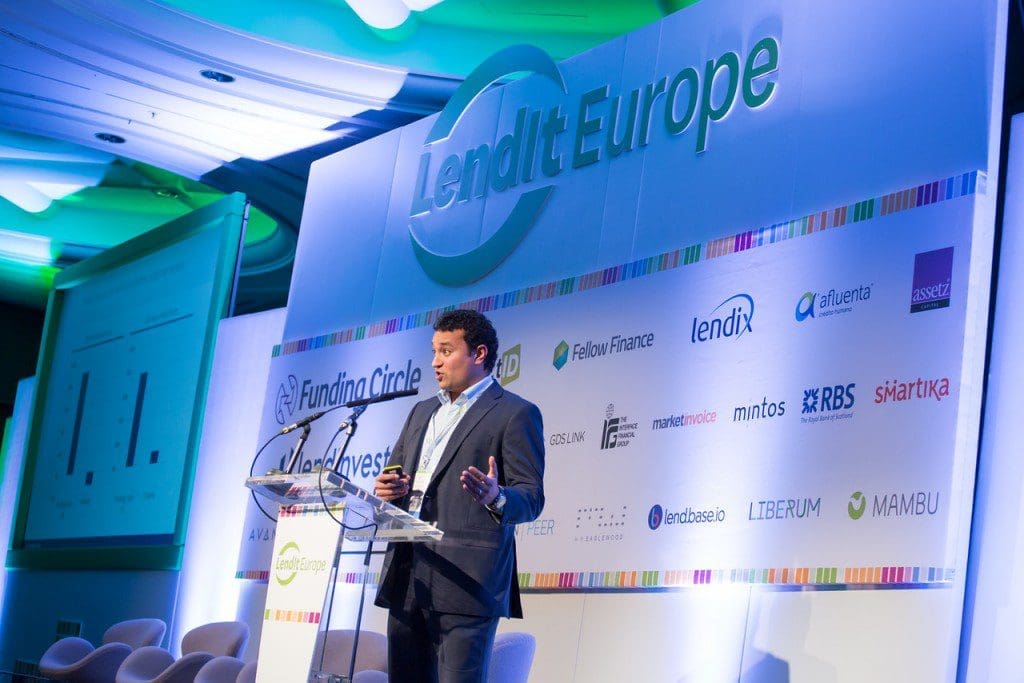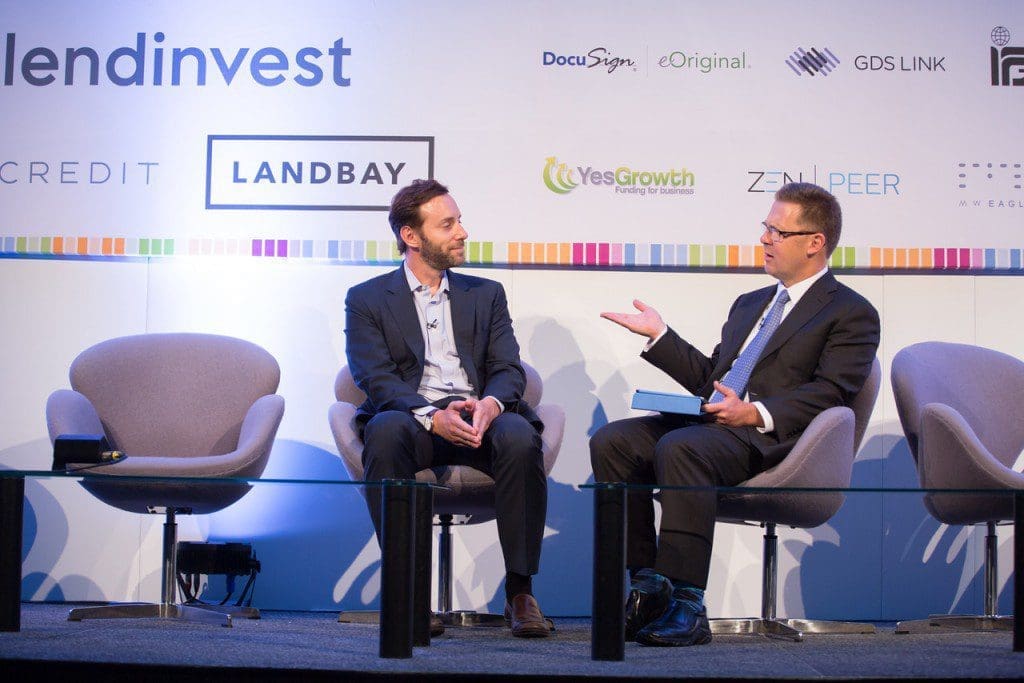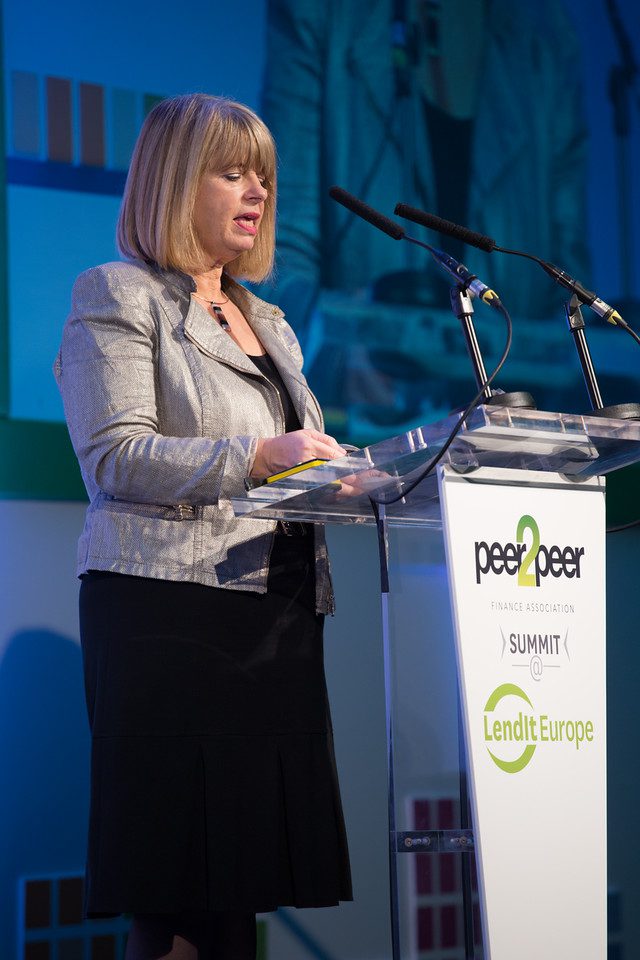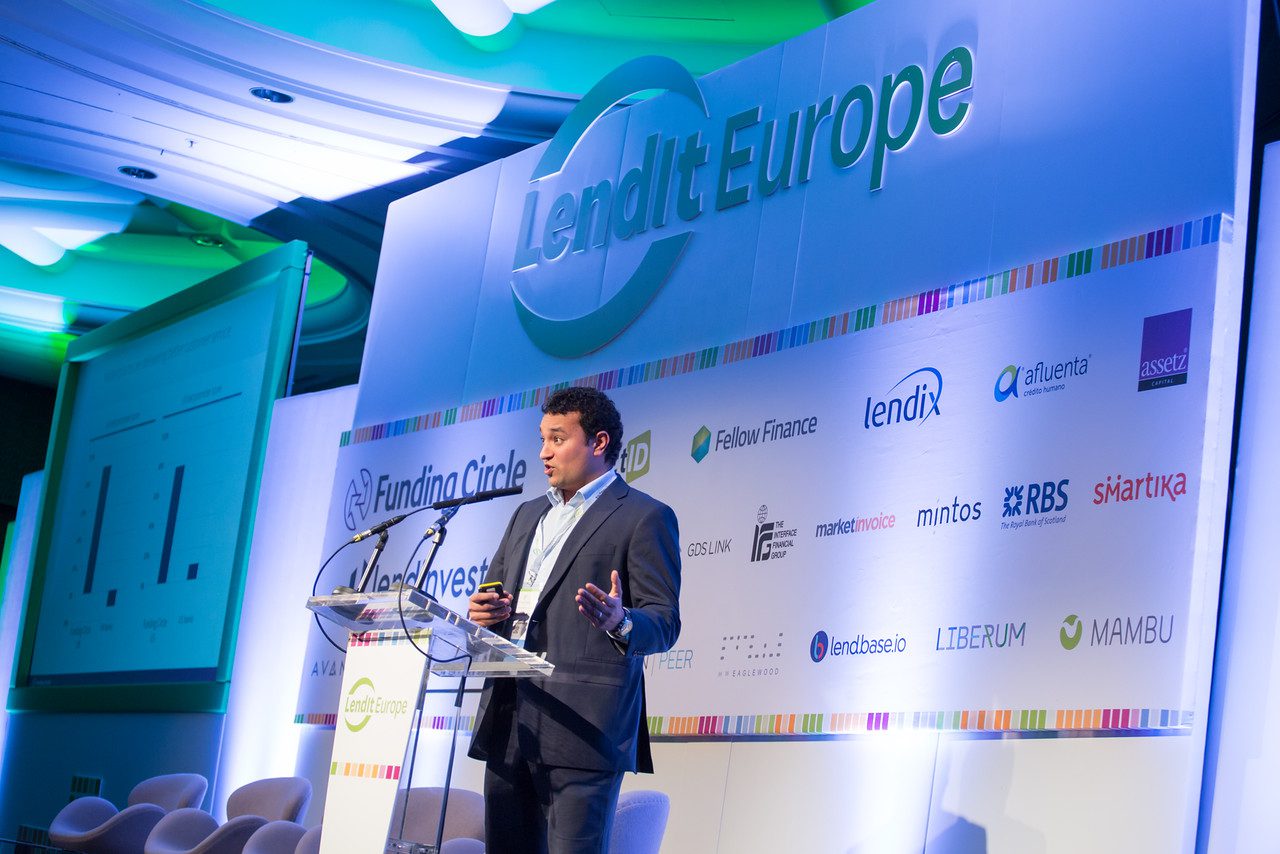We have just wrapped up the second annual LendIt Europe conference here in London. It was another great LendIt event with 754 people attending over two days at the Hilton London Metropole earlier this week. This was the largest ever gathering in Europe for our industry.
We kicked off LendIt Europe 2015 with a pre-conference cocktail party on Monday night at The Landmark Hotel – a beautiful old hotel just a few minutes walk from the Hilton. There was quite a festive mood among the crowd as everyone was looking forward to the two days ahead.
Some of the Conference Highlights

Bright and early on Tuesday morning LendIt Europe began with a keynote from the CEO and co-founder of Funding Circle, Samir Desai. Samir started with a major announcement: that Funding Circle was joining forces with Zencap, a European platform operating in Germany, Spain and the Netherlands. Zencap will be rebranded to Funding Circle CE (for Continental Europe). This expands Funding Circle’s footprint from two countries to five and establishes them as the clear global leader in small business lending in this industry.
Samir’s keynote also presented some interesting ideas. He reiterated Funding Circle’s intention to lend $100 billion per year within 10 years and said that for a bank to lend that much money they would need $10 billion of capital, whereas a true marketplace would need only a tiny fraction of that. He also said that the only way that a marketplace lending platform could be truly aligned with investors is to not take balance sheet risk. If a financial crisis occurs again hybrid platforms (those that have both a marketplace and a balance sheet) will be tempted to offload their worst performing loans from their balance sheet – a true marketplace cannot do that.
Cormac Leech of Liberum gave a fascinating presentation full of detailed charts and analysis as well as some bold claims. Cormac thinks that even though online lending in Continental Europe is a fraction the size of the UK today, it is growing much faster so he expects by 2020 it will overtake the UK in terms of loan volume. The regulatory environment has held the market back but there are signs this is changing.
He also showed how consumer credit, specifically credit cards, has been a high performing asset class over the past 20 years with much lower volatility than equities. He presented the idea that there should be a central data repository that automatically monitors and cross references all loans to individual bank statements. This would be a way to combat fraud. While there was a great deal more excellent content in Cormac’s presentation he left us with this radical thought: that central banks might eventually play an active role in marketplace lending by buying and selling pools of loans, via the ABS market, as part of their open market operations.
Rupert Taylor of AltFi Data gave an excellent presentation about the institutional investments in the top three UK platforms: Funding Circle, RateSetter and Zopa. The first interesting point he made is that the market share of the big three platforms has stopped eroding as these three companies are growing faster than the rest of the industry. Although, he did provide a caveat and say that the fastest growing sector in the UK right now is property, led by the likes of LendInvest.
What was also fascinating was to see the institutional versus retail breakdown at the major platforms. Zopa, the largest of the big three, also has the largest percentage of institutional investors – at 63% of its loan volume in September. Funding Circle just allocated over 50% of its loan volume to institutional investors for the first time while at RateSetter they are still nearly 100% retail but their target is up to 30% going forward. Institutional investors are receiving roughly a 1% higher return than retail but they are taking on substantially more risk according to Rupert.
Karen Mills, the former head of the U.S. Small Business Administration, who also gave a keynote at LendIt USA 2015, made the trip over to London for LendIt Europe. She compared the small business lending environment in the U.S. and UK, noting that while lending to small businesses has improved in the U.S. since the financial crisis, it has yet to recover in the UK. She also noted that around 89% of small business loans are provided by just four banks and their share of the market has actually increased over the last 15 years. Karen discussed the importance of bank partnerships – banks are still the first place that small business turn to when looking for a loan.

We finished the morning session with a discussion between Prosper president, Aaron Vermut, and myself. I asked him what is key to scaling a business from less than $10 million in loans a month to several hundred million. He said that the most important thing is the willingness to fail. When he joined the business, he took big risks, changing the whole corporate structure and underwriting strategy of the company. They also invested money in customer acquisition, being aware that this marketing spend may not immediately translate into revenue.
I also asked about the threat of new entrants into the industry and whether or not it is becoming harder to acquire customers. Aaron said that by focusing on operational excellence and an efficient process of getting customers through their borrower funnel, new entrants, who mostly acquire their customers though paid search, do not pose a significant threat. Aaron then spoke about the acquisition of BillGuard and the opportunity it presents to engage with customers before and after they have received a loan. I ended with a question about a possible Prosper IPO. Aaron was predictably coy although he did say that with the current environment in public markets a Prosper IPO is not happening any time soon.
After lunch LendIt Europe split into two tracks, an Investor Track and a Platforms. I was the MC of the Investor Track where we heard from Simon Champ of Eaglewood discussing exactly what permanent capital is and why it is good for all three constituents in marketplace lending: the borrower, the platform and the lender. If any one is these constituents is unhappy then the other two will suffer.
Angela Ceresnie of Orchard talked about the increasing sophistication of both the marketplace lending investors as well as the platforms. But there are still many challenges and things we need to see in the future such as a secondary market, benchmarking and industry accepted standards.
On the Institutional Investor panel there was a lot of talk about the fraud at Trustbuddy. None of the investors on the panel had any exposure to Trustbuddy and they all said that their own due diligence would have discovered the problems. But they all agreed it was a wakeup call to institutional investors and that it should sharpen everyone’s due diligence process from now on.

There were many more excellent sessions on day one and I recommend you read the LendIt Day One recap for more.
Day Two: P2PFA Summit @ LendIt Europe
The Peer to Peer Finance Association (P2PFA) is probably the leading association of its kind in the world and day two at LendIt Europe was a joint production between the P2PFA and LendIt called the P2PFA Summit @ LendIt.
Christine Farnish, the chair of the P2PFA gave some short opening remarks and then introduced Chris Woolard, the Director of Strategy and Competition at the Financial Conduct Authority (FCA) to give the opening keynote. He emphasized that the role of the FCA was not just to protect consumers but to encourage competition in the interests of consumers. Their approach to the regulation of P2P lending in the UK has been firmly market oriented and they wanted the regulation to build confidence both with consumers and entrepreneurs who are running platforms. They have put an emphasis on the segregation of client funds as a key piece to build that confidence.
Peter Wilson is the CEO of British Business Bank Investments, a government owned investment firm, that has £1.5 billion in capital, some of which is invested in five UK small business platforms. Their mission is to channel money to small businesses and partnering with the P2P lending platforms is one way to do this. They like to invest between £10 million and £50 million on platforms, so they are not suitable for startups. They have a double mandate: help provide capital access to small businesses and to show a return to the taxpayers.

Harriett Baldwin MP, the Economic Secretary to Treasury, spoke about the need for the government to inject choice and competition into P2P lending as well as incentivizing banks to offer the best level of service to their customers. At the same time, the barriers for new entrants should be kept low, and a single strong competition regulator is an important step towards creating real opportunities for innovative firms to enter the market. She touched upon the importance of the fintech sector in general and mentioned the establishment of the Alan Turing Institute with the goal to ensure the supply of brainpower that is being nurtured in the UK.
We heard from many of the P2PFA members, who gave short keynotes, along with panel discussions. But my favorite session of the morning was the debate between Cormac Leech of Liberum and Matt Hammerstein of Barclays. I moderated the debate and as expected it was a lively discussion. Cormac believes that in ten years’ time, banks will have their “Walmart” moment as they realize that their business has moved away, similar to the way book stores and music publishers lost their business to Amazon and Spotify. Matt thinks that it is too early to make such statements until we can see how online marketplace lending platforms perform through the credit cycle. He thinks that this sector will continue to grow, but the rate of growth is uncertain.
In the afternoon we split into two tracks again and I was MC of the Moving Beyond the UK track. We had three panels focused on Continental Europe and an excellent keynote by Henry Yin of Chinese platform CreditEase who summarized the opportunity in China beautifully.
The last session of the day was the Deep Dive into the U.S. Platforms panel, moderated by Matt Burton of Orchard, where we heard several pieces of news. Rob Young from OnDeck discussed the announcement that they would be expanding to longer term loans with interest rates as low as 5.99%. Albert Periu from Funding Circle gave more color to their recent acquisition of Zencap. Adam Hughes of Avant discussed their international expansion strategy and that they would be opening up in Australia early next year. Aaron Vermut of Prosper announced they would be launching a point of sale product very shortly and they are also working on a no origination fee product that would directly compete with platforms like Avant. There was also some discussion of the challenges of getting international money into the U.S.
There were many more highlights beyond what I have described here so I encourage you to read the LendIt Day Two summary as well as the excellent review by Claus Lehman of P2P-Banking.com. I also recommend you watch the videos – we recorded every session and many are on our site already. Many people requested to see the slide presentations from the main tracks – they are now available on the LendIt site. Also, there were many, many announcements from companies at LendIt – you can read them all on the LendIt press page.
Final Thoughts
In many ways I felt like this was our best production ever for a LendIt event. The LendIt team worked ridiculously hard in the weeks leading up to the event and it showed as everything worked flawlessly. The signage looked great, the exhibition hall was buzzing with activity, the sessions were well attended and the live stream worked really well. Of course, it wasn’t perfect and I know we can do even better next year. It was a great end to a very busy year for me personally and the entire LendIt team.



